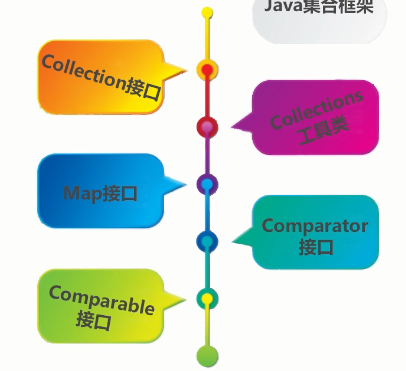-
Exception的父类是Throwable捕获到的异常,可以在当前方法的 catch 块中处理,也可抛出给调用者去处理
查看全部 -
String类的常用方法
 查看全部
查看全部 -
catch注意顺序,从子类向父类写
int xx=input.nextint();
查看全部 -
throwable有error(主要是系统错误)和exception(有runtimeexception,称为非检查异常)两个类,非检查异常又分为空指针异常,数组下标越界异常,类型转换异常以及算术异常
查看全部 -
Comparable接口的比较

omparator 接口

java中集合框架有:
Collection接口(List接口(ArrayList类)、Queue接口(LinkedList类)、Set接口(HashSet类))
Map接口(HashMap类)
Collections工具类(进行Collection对象操作,最常用List的sort方法)
Arrays工具类(针对数组进行操作)
查看全部 -
studentList.add(new Student(1 + "","小明"));
为什么是这样书写 (1+"")这就是一个字符串啊,数字+""就转成字符串了,等同于"1"。查看全部 -
package package1;
import java.util.ArrayList;
import java.util.Collections;
import java.util.List;
import java.util.Random;
public class CollectionsTest2 {
List<String> stringlist = new ArrayList<String>();
Random random = new Random();
String str="abcdefghijklmnopqrstuvwxyzABCDEFGHIJKLMNOPQRSTUVWXYZ0123456789";
public void stringTest() {
for(int i=10;i<20;i++) {
int j = random.nextInt(10)+1;
StringBuilder string = new StringBuilder();
for(int x=0;x<j;x++) {
int y = random.nextInt(str.length());
string.append(str.charAt(y));
}
String string1 = string.toString();
stringlist.add(string1);
System.out.println("添加字符串"+string1);
}
System.out.println("——————————排序前——————————");
for(String str:stringlist) {
System.out.println(str);
}
Collections.sort(stringlist);
System.out.println("——————————排序后——————————");
for(String str:stringlist) {
System.out.println(str);
}
}
public static void main(String[] args) {
CollectionsTest2 a =new CollectionsTest2();
a.stringTest();
}
}
查看全部 -
Collections工具类
java.util.Collections
是Java集合框架中,用来操作集合对象的工具类,与Map,Collection并列的
也是Java集合框架的成员
string 类型排序顺序---先是第一列,然后第二列,依次进行
数字:0-9
大写字母:A-Z
小写字母:a-z
package package1;
import java.util.ArrayList;
import java.util.Collection;
import java.util.Collections;
import java.util.List;
import java.util.Random;
class CollectsTest {
public void testSort1() {
List<Integer> integerlist = new ArrayList<Integer>();
Random random = new Random();
Integer k;
for(int i=0;i<10;i++) {
do {
k=random.nextInt(100);
}while(integerlist.contains(k)) ;
integerlist.add(k);
System.out.println("成功添加了"+k);
}
System.out.println("————————————排序前————————————");
for(Integer integer:integerlist) {
System.out.println("元素"+integer);
}
Collections.sort(integerlist);
System.out.println("————————————排序后————————————");
for(Integer integer:integerlist) {
System.out.println("元素"+integer);
}
}
public void testSort2() {
List<String> stringlist = new ArrayList<String>();
stringlist.add("aaa");
stringlist.add("abbbb");
stringlist.add("Aaaa");
stringlist.add("badsaf");
System.out.println("——————排序前————————");
for(String str : stringlist) {
System.out.println(str);}
Collections.sort(stringlist);
System.out.println("——————排序hou————————");
for(String str : stringlist) {
System.out.println(str);}
}
public static void main(String[] args) {
// TODO Auto-generated method stub
CollectsTest a =new CollectsTest();
a.testSort2();
}
}
查看全部 -
try-catch-finally
try{
//一些会抛出异常的方法
}catch (Exception e){
//处理该异常的代码块
}catch (Exception2 e){
//处理Exception2的代码块
} finally {
//最终将要执行的代码
}
e.printStachTrace();-打印出具体的异常信息。
try catch finally语句先执行catch然后再finally 最后返回main方法中的调用者
查看全部 -
try-catch异常处理
try{
//一些会抛出异常的方法
} catch (Exception e){
//处理该异常的代码块
}
try抛出很多种类的异常时,需要多重catch捕获
使用多重catch时,一定要注意顺序问题,先小后大,即先子类后父类的顺序捕获异常。
查看全部 -
Exception类包括非检查异常【RuntimeException】和检查异常
非检查异常分为
空指针异常【NullpointerException】,
数组下标越界异常【ArrayIndexOutOfBoundsExceotion】,
类型转换异常【ClassCastException】,
算术异常【ArithmeticException】等,
这种异常会由Java虚拟机自动抛出并自动铺获
检查异常主要有文件异常【IOException】
finally{
无论是否发生异常都会执行的代码
}
查看全部 -
package immoc.collection;
import java.util.ArrayList;
import java.util.Collections;
import java.util.List;
import java.util.Random;
public class CollectionsTest {
public void testSort1() {
List <Integer> integerList=new ArrayList<Integer>();
Random random =new Random();
Integer k;
for (int i = 0; i < 10; i++) {
do {
k=random.nextInt(100);
} while (integerList.contains(k));
integerList.add(k);
System.out.println("添加"+k);
}
System.out.println("=======qian=======");
for (Integer integer:integerList) {
System.out.println("before"+integer);
}
Collections.sort(integerList);
System.out.println("========hou========");
for (Integer integer:integerList) {
System.out.println("after"+integer);
}
}
public void testSort2() {
List<String> stringsList=new ArrayList<String>();
Random random=new Random();
Integer kInteger;
for (int i = 0; i <10; i++) {
Integer tempLength =random.nextInt(10);
StringBuilder temp = new StringBuilder(tempLength);
do {
for (int j = 0; j < tempLength; j++) {
int charInt;
charInt=(random.nextInt(95)+32);
temp.append(String.valueOf((char)charInt));
}
} while (stringsList.contains(temp));
stringsList.add(temp.toString());
System.out.println("添加"+temp.toString());
}
System.out.println("=======qian=======");
for (String st:stringsList) {
System.out.println("before"+st);
}
Collections.sort(stringsList);
System.out.println("========hou========");
for (String st:stringsList) {
System.out.println("after"+st);
}
}
public static void main(String[] args) {
// TODO Auto-generated method stub
CollectionsTest collectionsTest=new CollectionsTest();
collectionsTest.testSort2();
}
}
查看全部 -
String 对象创建后则不能被修改,是不可变的,所谓的修改其实是创建了新的对象,所指向的内存空间不同。
查看全部 -
public class Student implements Comparable<Student>{
@Override
public int compareTo(Student o){
return this.id.compareTo(o.id);//字符串类型实现了compareTo接口
字符串先比较第一位排序
把comparator作为参数传递给sort方法
sort(list,comparetor)
collections.sort(student,new studentcomparator);
}
}
查看全部 -
comparable定义了对象的默认比较规则
comparator定义了对象的临时比较规则


 查看全部
查看全部
举报









